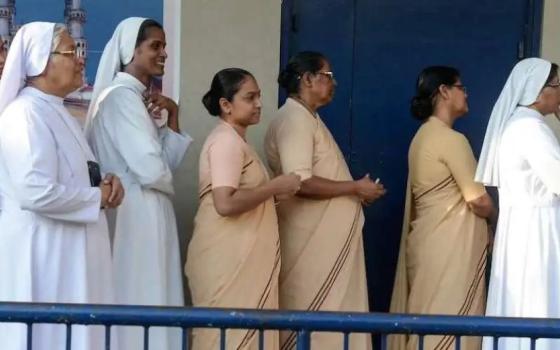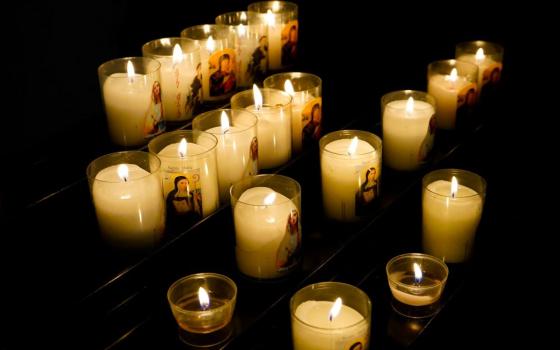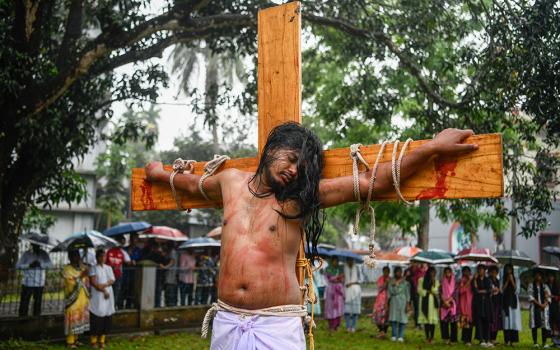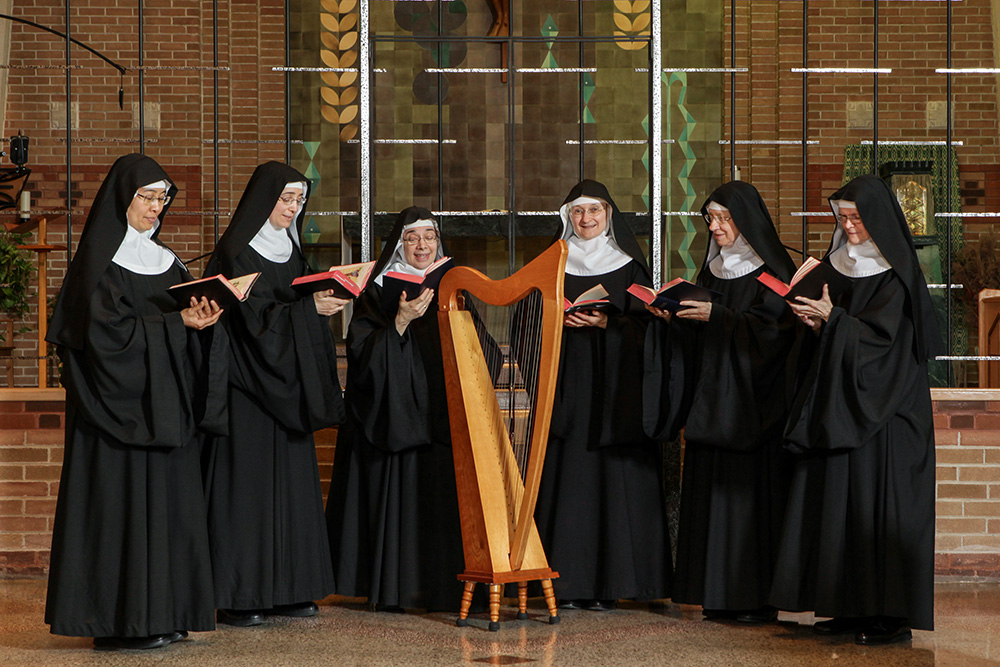
The Benedictine sisters of the Abbey of Sainte-Marie des Deux-Montagnes in Sainte-Marthe-sur-le-Lac, Quebec pose for a photo gathered around a harp in their community. (Courtesy of Serge Therrien)
The nuns at the oldest Benedictine monastery in the province of Quebec, Canada, are known to live behind a grille. But, for nearly two years, the Abbey of Sainte-Marie des Deux-Montagnes, founded in Sainte-Marthe-sur-le-Lac in 1936, opened its doors to filmmaker Lessandro Sócrates, who captured their day-to-day life.
The documentary, titled "De l'autre côté" ("On the Other Side"), originally aired in French with English subtitles in Quebec cinemas Nov. 17-27, 2022, and was presented a second time March 22-April 4, 2024. It is currently available for streaming in French on YouTube.
The sisters who took part in the documentary belong to a contemplative community headed by the Abbey of Saint-Pierre de Solesmes in France and to a family of monasteries called the Solesmes Congregation.
The sisters are filmed as they go about their usual routines, praying, singing, playing instruments, working, laughing, preparing icons, or simply sliding in the snow. During 83 minutes, Sócrates reveals the love and friendship of 20-some cloistered religious who, despite living contemplatively, share an uncommon joie de vivre and love for the Gospel, far removed from the austere life some believe they lead.
"The viewers of the film can see what a great sense of humor the nuns have and their sense of fun at recreations," Sr. Agnes Valderrama, one of the Benedictine sisters, told Global Sisters Report in an interview. "One of the main characteristics of the community which Lessandro skillfully brought to light in his film is the deep and immense joy of the nuns who live the spiritual values and riches of the cloistered, monastic life."
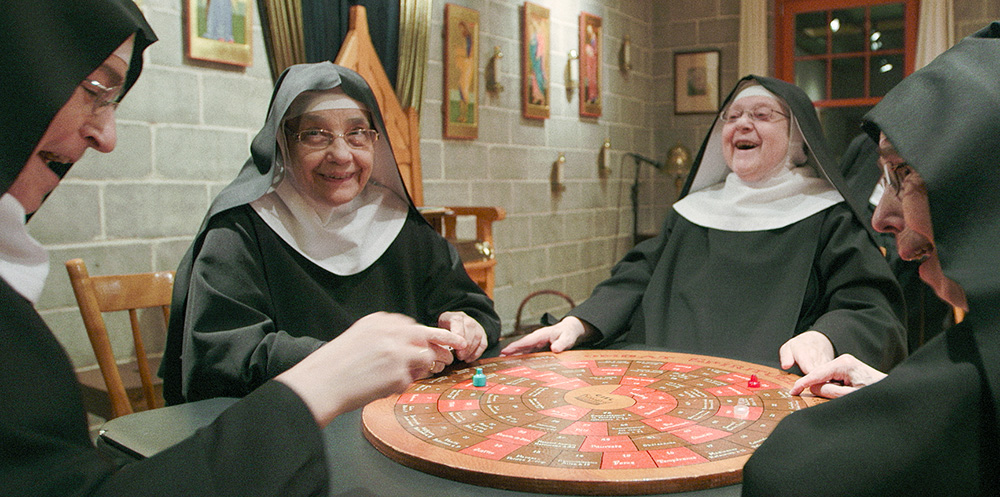
In a still image from the documentary "De l'autre côté" ("On the Other Side"), the Benedictine sisters of the Abbey of Sainte-Marie des Deux-Montagnes laugh as they try to reach "Heaven" in a board game. (Courtesy of Lessandro Sócrates)
The film is also an homage to the ancient tradition of Cluny as the Benedictine sisters celebrate the Divine Office in Latin and the sound of Gregorian hymns. The prayers and worship life is their foundation for growth in sanctity. This is depicted in the film in contrast with moments of prolonged silence.
"St. Benedict says that the monastery is the school of divine service. Through Gregorian chant, the community is also of service to the universal church," said Valderrama "We pray with, through and for the church, for those who don't have time to pray. The founder of our Benedictine congregation, Dom Guéranger, defines the church as the society of divine praise. Guests who include clergy and lay are attracted by the beauty, serenity and uplifting character of the chant, thereby serving also as an evangelizing instrument."
Ongoing prayer is depicted as the center of their community life in the film.
"As the film progresses, one can sense and begin to realize that what holds this community in one, in unity, and in loving charity is this ongoing liturgical prayer, which of course has its roots in the heart of each sister who is all given to Christ and follows him in a life of continual contact with him, in great intimacy with him," said Mother Abbess Isabelle Thouin.
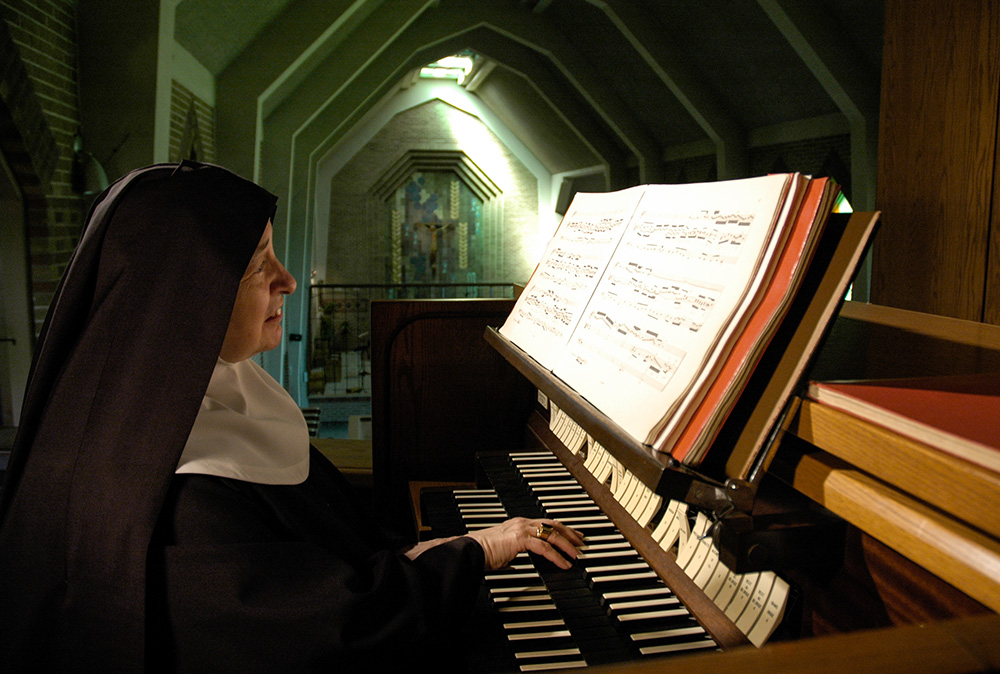
Mother Abbess Isabelle Thouin plays the organ at the Abbey of Sainte-Marie des Deux-Montagnes in Sainte-Marthe-sur-le-Lac, Quebec. (Courtesy of Philippe Hachey)
"This life is nourished by the word of God continually repeated and prayed and sung, all through the day, all through the life of each sister," she said. "The summit and center of their life and of each day of their life is the holy sacrifice of Mass: the eucharistic sacrifice."
The film also captures the importance of music in this community. The community has produced CDs of Gregorian chants and their abbess is an accomplished musician and organist, formed in the school of music in Paris on a high level. Two sisters play the organ, and others play the harp, the flute or the piano. The scenes are natural, appear almost unedited, and allow us to see the sisters as they are.
"I was amazed that he filmed and used what I said while practicing the organ, I didn't think it could be used! I was surprised," Sr. Bernadette Roy told GSR. "The film perfectly captures our lives, and what we loved was that we were seen in our natural state. It's the real thing, with no make-up — that's just the way we are."
The humanity of the sisters is portrayed with raw footage of what is typically seen behind the scenes of a movie, seemingly lifting any preconceived notion that exists about cloistered life.
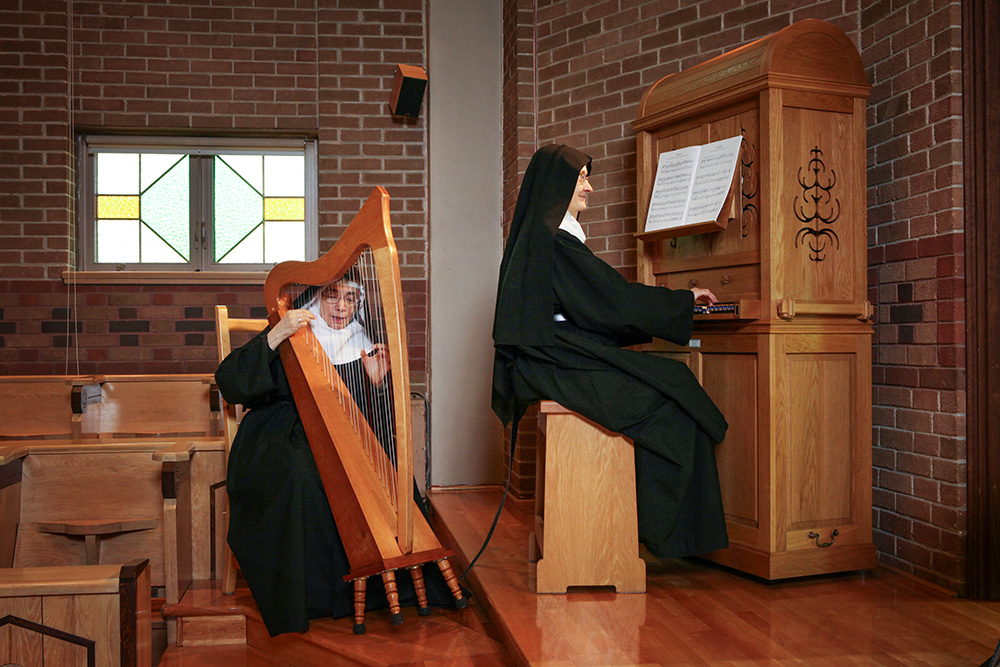
Benedictine Srs. Bernadette Roy, left, and Madeleine Saint-Aubin share their love of music as they engage in a duet at the Abbey of Sainte-Marie des Deux-Montagnes in Sainte-Marthe-sur-le-Lac, Quebec. (Courtesy of Serge Therrien)
"I was pleasantly surprised to find that the film was so candid as to include, paradoxically, dialogue between the nuns, and nuns with the cameraman. In a certain sense, it gave even more life to the film in showing the human side of the sisters, enjoying one another's company, sense of humor, and having fun in childlike simplicity, breaking the often preconceived idea that cloistered nuns are somehow stiff, always serious and imprisoned in a cage," said Valderrama.
"There are no interviews and no commentaries. We can hear a few exchanges of reflections between the sisters," Roy wrote in her community's column in 2022.
The cloistered nature of the life of the Benedictine nuns is shown through close images of a grille that separates the sisters from the altar sanctuary when they receive Communion or from a visiting priest who brings them news about other communities. However, these scenes are not meant to be misunderstood.
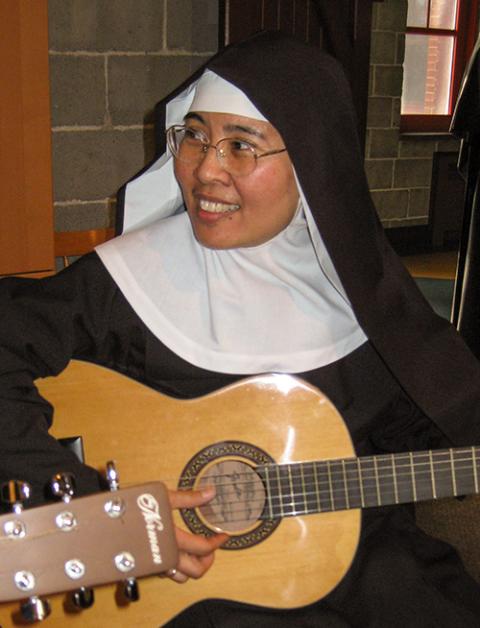
Benedictine Sr. Agnes Valderrama plays guitar. (Courtesy of Abbey of Sainte-Marie des Deux-Montagnes)
"The grille that you see in the film is deceiving because, from the sisters' point of view, we don't have a grille in front of our faces all day long. We are in our workshops, kitchen, refectory, Blessed Sacrament chapel; even in choir we don't make that difference," said Valderrama.
However, the grille is a memento of their vows.
"The grille serves as a protection and reminder to the nun that she has given herself entirely to God and symbolizes her retreat or withdrawal from the busyness and distractions of the world," Valderrama explained "The enclosure marked off by the grille promotes the space of silence for recollection and solitude with God — not isolation — at the same time as living in community.
"The enclosure marked by the grille also gives witness to the world that it is worth giving up everything to give ourselves entirely to God who is all in all. The enclosure marked by the grille does not mean that the nuns are in prison, but so that they can have the freedom to put God first."
The film also portrays the sisters' relationship to the Catholic Church and their bishop, Gilles Cazabon, an Oblate and bishop emeritus of Saint-Jérôme. Cazabon was present at the monastery during the filming.
In one scene, the sisters watch a video of Pope Francis in St. Peter's Square as small children are being handed over to be blessed. This scene greatly amuses the nuns who exclaim at the video with laughter: "Another baby! Another one!"
"Our insertion into the church, our intimate link with the pope and the bishops, and our love of the Second Vatican Council play a fundamental role in our life of faith and consecration at the heart of the church," said Roy.
Advertisement
Friendship born out of love for iconography
Sócrates, a Brazilian-born filmmaker, arrived in Canada in 2011 and was introduced to the Benedictines through the art of iconography as they were both learning it in a Montreal studio. This form of art, taught by Alexander Sobolev using a 15th-century technique, caught the attention of Sócrates, who documented it in a short 13-minute portrait movie called "The Iconographer."
Meanwhile, the friendship between Sócrates and the nuns grew, which in turn led to the making of the documentary "On the Other Side."
"I found him full of humor, and also very discreet, observing us and taking an interest in us and our lives," said Sr. Louise Lussier, one of the monastery's iconographers.
In "The Iconographer," the sisters are shown in the atelier preparing icons to be painted and written, as one is educating the other on the delicate art of iconography. The audience gets to witness the attention to detail present in all of the sisters' work.
"It needs to be perfect to sell," says one of the sisters, as she smoothes out the edges of an icon.
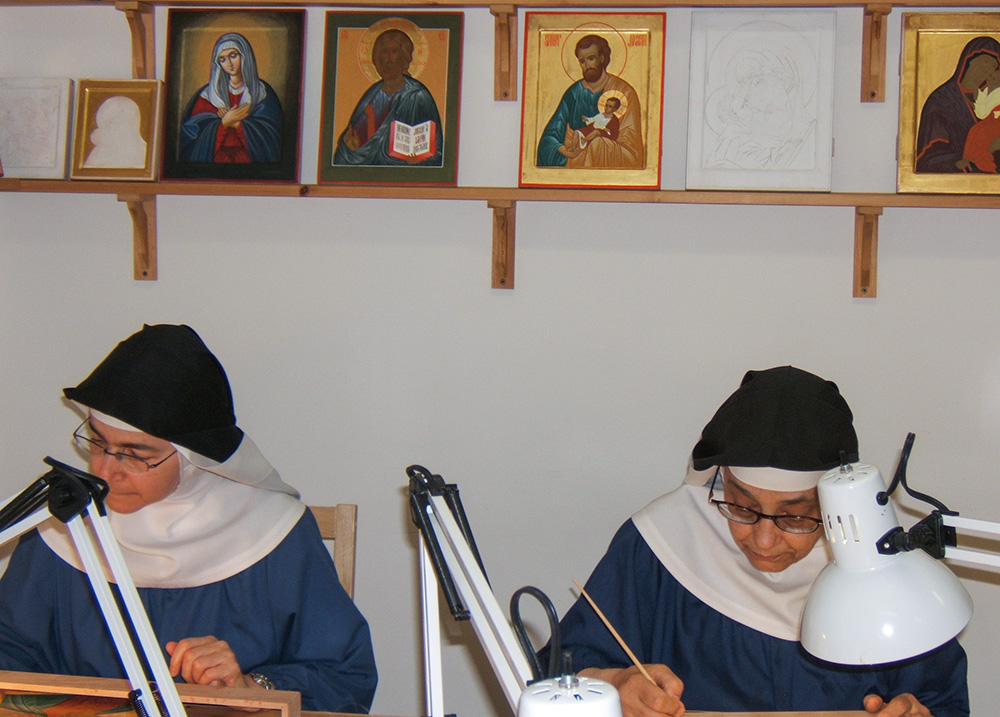
Benedictine Srs. Martine Roy and Sr. Louise Lussier prepare icons in their atelier at the Abbey of Sainte-Marie des Deux-Montagnes in Sainte-Marthe-sur-le-Lac, Quebec. (Courtesy of Serge Therrien)
Currently, Benedictine Srs. Louise Lussier, Martine Marie Roy, Agnes Valderrama and Angelica Marie Pham spend one to two hours daily on iconography.
"What is so useful about our work of iconography is that it is an instrument for ecumenical dialogue, as we are very active in the ecumenical movement. Icons united East and West as a religious art form and expression of our common faith," said Valderrama.
Sócrates is known to be fascinated by topics that are out of the ordinary.
"The subject matter is rare, and what goes far beyond curiosity, is that seeing monks and nuns in their daily lives can do some good," Roy said. "It makes you realize that we're all made for something other than material possessions and that life's little troubles don't prevent the radiance of eternal life, which begins in the depths of the soul."
The documentary features intimate scenes of sisters who appear to be bowing in front of the camera, but who are in reality bowing in front of the Blessed Sacrament.
"Lessandro was given access to very intimate parts of the monastery, guided and accompanied by a sister of the community," Valderrama said. "We appreciated his great respect for the religious life and discretion when filming. He was able to position himself in areas that are off-limits to the public."
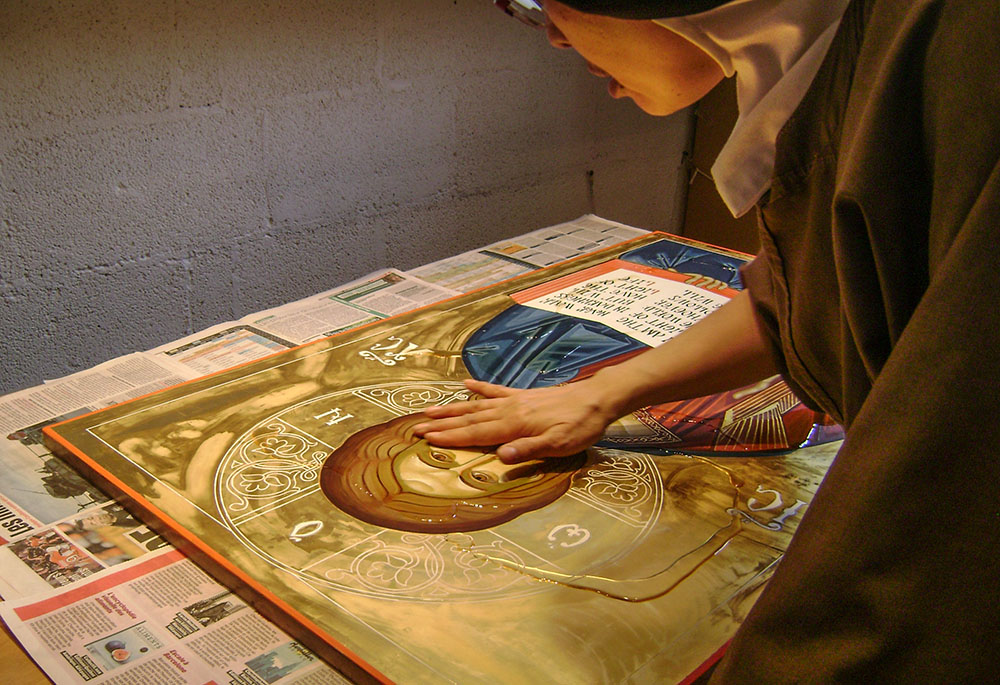
Benedictine Sr. Agnes Valderrama varnishes an icon with linseed oil, the last step in writing an icon, at the Abbey of Sainte-Marie des Deux-Montagnes in Sainte-Marthe-sur-le-Lac, Quebec. (Courtesy of Abbey of Sainte-Marie des Deux-Montagnes)
She added, "He also was given access to the sacristy, to be well positioned for filming the priest incensing the Blessed Sacrament during adoration. Lessandro displayed a great eye for detail and sensitivity to the nuns praying, whether privately or during the liturgy."
The community was satisfied with the documentary, as Roy wrote in the community's column in November 2022.
"Each of us recognized 'our real life,' unvarnished, unostentatious, transparent," she wrote.
Beyond realistically capturing the lives of the sisters, the film allowed the audience to enter into the silent life of their community, characterized by unity.
"What I like about this movie is the space and silence in which it allows us to enter into, and slowly we feel the unity of life of the nuns, and then we enter into the joy of their life and then we participate into the unity of life of the community," said Thouin.
Elizabeth Lo, 37, has visited the monastery frequently since 2019. She told GSR that she always wondered what contemplative nuns do behind the grille.
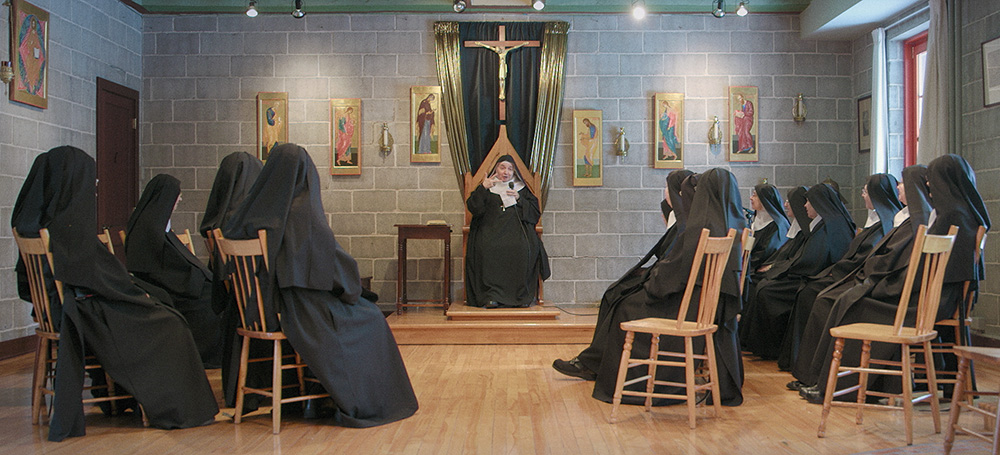
In a still image from the documentary "De l'autre côté" ("On the Other Side"), the Benedictine nuns listen during a conference by Mother Abbess Isabelle Thouin in the chapter house of the Abbey of Sainte-Marie des Deux-Montagnes in Sainte-Marthe-sur-le-Lac, Quebec. (Courtesy of Lessandro Sócrates)
"I asked myself, 'Do nuns pray all day and don't do anything else? Are they allowed to talk? Are they always super serious and never smile or talk to each other? Are they allowed to drink coffee and eat desserts?' I really wanted to know. The documentary allows me to see the day-to-day life of real nuns behind the grille," Lo said.
"This documentary has given me a new perspective on religious life in general," Lo added. "After seeing the documentary, I no longer think that nuns are extremely serious people who don't talk, who pray all day, and do nothing else. The nuns do pray a lot, but they also have so much fun all day long. I have discovered that life in a monastery is rich and never boring — accompanied by really good music."
Sócrates was contacted for an interview but declined to comment. However, according to the sisters he was pleased with the final result.
"Lessandro was delighted to see the movie theaters filled to capacity for the presentation, and to hear viewers say they were touched by the spirituality, joy, and enthusiasm that emanated from it," Roy said. "In these days, when religious communities are often misperceived in the world, here is a face that makes them loved and, we hope, will above all make people love the Lord and prayer."

The Abbey of Sainte-Marie des Deux-Montagnes in Sainte-Marthe-sur-le-Lac, Quebec (Courtesy of Philippe Hachey)

